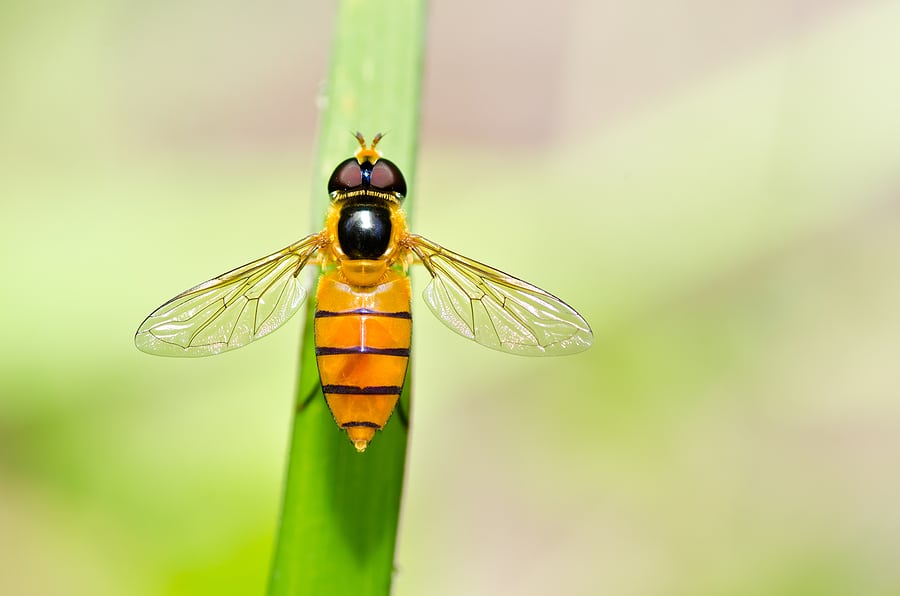How to Get Rid of Fruit Flies?

Do you find pesky fruit flies buzzing around your kitchen, causing annoyance? Don’t worry, we’ve got you covered on how to eliminate them easily. Firstly, start by creating a simple homemade trap by taking a small bowl and filling it with a mixture of apple cider vinegar and a few drops of dish soap. The fruity scent of the vinegar will attract the fruit flies, while the dish soap will trap and drown them. Place the bowl in a prominent spot and watch as those bothersome flies quickly become a thing of the past.
Another effective way to get rid of fruit flies is by keeping your kitchen clean and free of ripe or rotting fruits. Make sure to store your fruits in the refrigerator or in a sealed container to avoid attracting these unwanted visitors. Additionally, regularly wipe down your countertops and clean up any spills or scraps, as fruit flies thrive in dirty and moist environments. By following these simple methods, you can bid farewell to fruit flies and enjoy a fly-free kitchen once again.
Understanding Fruit Flies
What are Fruit Flies?
Fruit flies, scientifically known as Drosophila melanogaster, are small insects that belong to the family Drosophilidae. They are commonly found in homes, particularly in the kitchen and areas where fruits and vegetables are present. These tiny pests are attracted to decaying and fermenting organic matter, making them a nuisance in households.
Life Cycle of Fruit Flies
Understanding the life cycle of fruit flies is crucial in tackling infestations effectively. Fruit flies undergo a simple metamorphosis, which consists of four stages: egg, larva, pupa, and adult. The process from egg to adulthood takes approximately 7-13 days, depending on temperature and environmental conditions. Their short life cycle, combined with their ability to reproduce rapidly, makes it essential to address infestations promptly.
The Most Common Types of Fruit Flies
While the term “fruit flies” is often used to refer to any small flies found around fruits, there are actually several species of fruit flies that can infest homes. The three most common types of fruit flies encountered in households are the Red-Eyed Fruit Fly (Drosophila melanogaster), the Dark-Eyed Fruit Fly (Drosophila repleta), and the Lesser Fruit Fly (Drosophila pseudoobscura). These species have slightly varying preferences in terms of breeding grounds and food sources, but they all share similar characteristics and habits.
Why Fruit Flies Are Attracted to Your Home
Fruit flies are drawn to the scent of ripe or fermenting fruits, vegetables, and other organic matter. They can detect the scent from quite a distance and have the ability to locate food sources quickly. Besides fruits and vegetables, fruit flies are also attracted to sugary substances like juices, honey, and soda. Additionally, they are known to be drawn to damp areas, garbage cans, and compost piles. Understanding what attracts fruit flies to your home is the first step in effective prevention and control.
Preventing Fruit Fly Infestations
Keeping Your Kitchen Clean
Maintaining a clean and tidy kitchen is essential in preventing fruit fly infestations. Be sure to clean up any spills promptly, wipe down countertops and surfaces, and regularly sweep or vacuum the floors. Pay close attention to areas where fruits and vegetables are stored, as fruit flies can quickly detect decaying produce. By keeping your kitchen clean, you eliminate potential food sources and breeding grounds for these pesky insects.
Handling Fruits Properly
Properly storing and handling fruits can significantly reduce the risk of fruit fly infestations. First, ensure that you check your produce for any signs of overripeness or decay before purchasing or using them. Store fruits in the refrigerator or in sealed containers to inhibit fruit flies’ access to them. If you notice any fruits starting to spoil, remove them promptly to prevent them from attracting fruit flies.
Trash and Compost Management
Trash cans and compost piles can be attractive breeding grounds for fruit flies. It is crucial to dispose of trash and compost properly to minimize the risk of infestation. Use tightly sealed bins for both trash and compost and regularly empty them to prevent the accumulation of organic matter. If you have a compost pile, make sure it is adequately covered and regularly turned to discourage fruit flies from breeding in it.
Regularly Inspecting Possible Breeding Grounds
Regular inspections of potential breeding grounds can help detect fruit fly infestations early on. Pay attention to areas such as drains, particularly those with any organic matter buildup. Cleaning drains regularly with a mixture of water and vinegar can flush out any fruit fly eggs or larvae. Also, inspect potted plants and any moist areas in your home, as these can be ideal breeding sites. Taking proactive measures to eliminate these breeding grounds will go a long way in preventing infestations.
Identifying Fruit Fly Infestation
Signs of Fruit Fly Infestation
Identifying the signs of a fruit fly infestation is crucial for effective control. Some common signs to look out for include the sudden appearance of small flying insects in your kitchen or near fruits and vegetables. These insects are typically small, about ⅛ inch in length, and have a tan or brown color. Additionally, you may notice an increase in fruit flies around garbage cans or compost piles. If you observe these signs, it is likely that you have a fruit fly infestation that requires immediate attention.
Areas to Check for Fruit Fly Infestation
When trying to determine the extent of a fruit fly infestation, it is important to thoroughly inspect areas where fruit flies are commonly found. Start by checking your kitchen, especially around fruit bowls, garbage cans, and drains. Look for any signs of eggs, larvae, or pupae in these areas. Additionally, inspect other rooms where fruits or organic matter may be present, such as dining areas or home offices. Recognizing the areas where fruit flies are present will help in developing an effective control strategy.
Determining the Extent of Fruit Fly Infestation
Assessing the extent of a fruit fly infestation is essential in determining the most appropriate control methods. Consider counting the number of fruit flies you observe and monitoring their population over a few days. This will help you determine if the infestation is localized or widespread. Keep in mind that fruit flies are highly mobile and can quickly spread, so early intervention is crucial to prevent further infestations.
Do-It-Yourself Fruit Fly Traps
Using Vinegar as a Fruit Fly Trap
One effective do-it-yourself fruit fly trap is using vinegar. Vinegar has a strong smell that attracts fruit flies, making it an excellent lure for them. To create a vinegar fruit fly trap, fill a small container with apple cider vinegar or red wine vinegar. Add a few drops of dish soap to break the surface tension. Place the container near areas with high fruit fly activity, such as fruit bowls or garbage cans. The fruit flies will be attracted to the vinegar and drown in the liquid.
Making a Paper Funnel Fruit Fly Trap
Another simple and effective fruit fly trap can be made using a paper funnel. Roll a piece of paper into a funnel shape, leaving a small opening at the tip. Place a small amount of overripe or rotten fruit at the bottom of a jar or container. Insert the paper funnel into the container, making sure the narrow opening is inside. The fruit flies will be attracted to the scent of the fruit and enter the container through the funnel. However, they will have difficulty finding their way out and eventually drown.
Using Wine to Attract Fruit Flies
Wine can also be used as a bait to attract fruit flies. Fruit flies are particularly drawn to the scent of red wine. Place some red wine in a small cup or container and cover it with plastic wrap. Poke a few small holes in the plastic wrap to allow the fruit flies to enter. As the fruit flies are attracted to the wine, they will enter through the holes but have difficulty finding their way out. Similar to other DIY fruit fly traps, they will eventually drown in the liquid.
Other DIY Fruit Fly Trap Ideas
In addition to vinegar, paper funnels, and wine, there are several other DIY fruit fly trap ideas you can try. Some popular choices include using a mixture of apple cider vinegar and dish soap, fermenting fruit or vegetable scraps in a jar, or placing overripe fruits in a plastic bag with small holes. Experimenting with different bait materials and trap designs can help you find the most effective solution for your fruit fly problem.
Using Natural Remedies to Kill Fruit Flies
Using Essential Oils Against Fruit Flies
Essential oils are a natural and aromatic method to repel and kill fruit flies. Several essential oils, such as lavender, lemongrass, and peppermint, are known to be effective in deterring fruit flies. To use essential oils against fruit flies, mix a few drops of the desired oil with water in a spray bottle. Shake the bottle well to ensure the oil is evenly distributed. Spray the mixture in areas where fruit flies are present or around windows and doors to create a barrier. The strong smell of the essential oils will repel fruit flies and prevent them from entering your home.
The Effectiveness of Citrus Peel
Citrus peels, particularly lemon and orange peels, can also be used to combat fruit flies. Fruit flies are averse to the scent of citrus, making it an effective natural repellent. Simply place the citrus peels in areas where fruit flies are a problem, such as around fruit bowls or near garbage cans. The citrus scent will deter fruit flies and discourage them from breeding or congregating in those areas.
How to Use Dish Soap to Kill Fruit Flies
Dish soap can be used as a natural and effective agent to kill fruit flies. Mix a few drops of dish soap with water in a spray bottle and shake well. When you spot fruit flies flying around, spritz the soapy water directly at them. The detergent in the dish soap disrupts the surface tension of the fruit flies’ wings, causing them to become trapped and unable to fly. This method is particularly useful for capturing individual fruit flies or smaller infestations.
Using Other Natural Ingredients to Kill Fruit Flies
Several other natural ingredients can be used to kill fruit flies effectively. For instance, a mixture of apple cider vinegar and a few drops of dish soap acts as a potent fruit fly trap. The vinegar attracts the fruit flies, while the dish soap breaks the surface tension, causing them to drown. Additionally, a combination of sugar and white vinegar in a bottle with a narrow opening can lure and trap fruit flies. These natural remedies provide an eco-friendly alternative to chemical insecticides and are safe to use around children and pets.
Commercial Fruit Fly Control Products
Available Fruit Fly Traps in the Market
If DIY methods are not yielding the desired results, there are several commercial fruit fly traps available in the market. These traps are designed to lure fruit flies and capture them effectively. They often use a combination of attractants, such as pheromones or food scents, to entice fruit flies into the trap, where they are unable to escape. Fruit fly traps can be purchased as ready-to-use traps or as refillable systems. Choose a trap that suits your needs and follow the manufacturer’s instructions for optimal usage.
Fruit Fly Sprays and How to Use Them
In addition to traps, fruit fly sprays can be another option for control. Fruit fly sprays are formulated to kill fruit flies upon contact, providing immediate results. When using a fruit fly spray, it is important to read and follow the instructions carefully. Spray the insecticide directly on the fruit flies or on surfaces where they are frequently seen. However, exercise caution when using these sprays around food preparation areas and follow all safety instructions to ensure the protection of yourself and others.
Evaluating the Effectiveness of Fruit Fly Control Products
While commercial fruit fly control products can be effective, it is important to evaluate their overall effectiveness and suitability for your specific situation. Consider factors such as the level of infestation, the cost of the product, and the potential environmental impact. Additionally, read product reviews and seek recommendations from others who have used the products to assess their efficacy. It may be necessary to try different products or combinations of methods before finding the most effective solution for your fruit fly problem.
Professional Fruit Fly Extermination
When to Hire a Pest Control Service
In certain situations, it may be necessary to seek professional assistance for fruit fly extermination. If you have a severe and widespread fruit fly infestation that you are unable to control using DIY methods or commercial products, it may be time to hire a pest control service. Pest control professionals have the expertise and specialized equipment to effectively eliminate fruit fly infestations, especially in complex or hard-to-reach areas. Also, if you have underlying structural or sanitary issues contributing to the infestation, a professional can help identify and address these problems.
What to Expect from Professional Fruit Fly Extermination
When hiring a professional fruit fly extermination service, you can expect a thorough assessment of your property and a customized treatment plan based on the extent of the infestation. The pest control technician will employ various methods, such as using insecticides, traps, or fumigation techniques, to eliminate the fruit flies and prevent their return. They will also provide recommendations on preventive measures you can take to minimize the risk of future infestations. Additionally, the professional service will usually offer ongoing monitoring and maintenance to ensure long-term fruit fly prevention.
Evaluating the Cost of Professional Extermination
The cost of professional fruit fly extermination services can vary depending on factors such as the size of the infestation, the complexity of the treatment, and the location of the property. It is advisable to obtain quotes from multiple pest control companies and compare their services and prices. While the cost of professional extermination may be higher than DIY methods or commercial products, it is essential to consider the potential savings in time, effort, and potential damage if the infestation continues to spread. Hiring a professional may provide a more efficient and long-lasting solution.
Long-term Fruit Fly Prevention
Regular Cleaning Habits
Developing regular cleaning habits is crucial in maintaining a fruit fly-free environment. Clean up spills and messes promptly, paying special attention to areas where fruits and vegetables are stored or prepared. Wipe down kitchen countertops and surfaces regularly, as well as inside and outside trash cans. Keep sinks and drains clean by regularly flushing them with hot water and a mixture of vinegar and baking soda. By incorporating these cleaning habits into your routine, you can significantly reduce the risk of fruit fly infestations.
Proper Food and Trash Storage
Proper storage of food and trash is paramount in preventing fruit fly infestations. Store ripe or overripe fruits and vegetables in the refrigerator or in sealed containers to minimize fruit fly access. Dispose of trash promptly in tightly sealed containers, and regularly clean and disinfect trash cans to eliminate any food debris. If you have a compost pile, make sure it is located away from your home and properly maintained to prevent fruit flies from breeding in it. By storing food and trash properly, you create an inhospitable environment for fruit flies.
Pest-Proofing Your Home
Taking proactive measures to pest-proof your home can help prevent fruit flies and other insects from entering. Seal any cracks or openings in windows, doors, and screens to deny entry to fruit flies. Install weather stripping on doors and windows to create a tighter seal. Use mesh screens on windows and vents to further prevent insect access. Additionally, ensure that outdoor garbage cans have tight-fitting lids to prevent fruit flies from finding a breeding site near your home. By making it difficult for fruit flies to enter your home, you minimize the chances of infestation.
Regular Inspections and Immediate Action on Infestation Signs
Regular inspections of your home can help detect fruit fly infestations early on. Monitor potential breeding grounds, such as fruit bowls, kitchen drains, and garbage cans, for signs of fruit fly activity. If you notice an increase in fruit flies or any signs of infestation, take immediate action to address the problem. Implement the appropriate control methods or seek professional assistance if necessary. Early intervention is key in preventing infestations from spreading and causing further problems.
Are the Methods for Getting Rid of Fruit Flies the Same for Getting Rid of Gnats?
Yes, the methods for getting rid of fruit flies can also be used to eliminate household gnats. Simple solutions like setting up apple cider vinegar traps, cleaning and sealing food waste, and using natural repellents like essential oils can effectively eliminate household gnats as well.
Health Risks Associated with Fruit Flies
Diseases Caused by Fruit Flies
While fruit flies may seem harmless, they can pose health risks through the transmission of disease-causing microorganisms. Fruit flies can carry bacteria such as Escherichia coli (E. coli) and Salmonella, which can contaminate food and lead to gastrointestinal illnesses. These bacteria can be transferred from fruit fly-infested areas onto surfaces or food through contact with their legs or proboscis. It is crucial to prevent fruit fly infestations and ensure proper hygiene practices to minimize the risk of foodborne illnesses caused by these pathogens.
The Dangers of Fruit Contamination
Fruit contamination by fruit flies can lead to significant economic losses and health hazards. Fruit flies lay their eggs on the surface of fruits, and the hatched larvae feed on the decaying fruit. As a result, the fruit becomes spoiled and inedible. This not only affects the quality and taste of the fruit but can also lead to food waste. In addition, contaminated fruits can harbor harmful bacteria and fungi, making them unsafe for consumption. Proper fruit storage, handling, and prevention measures are essential in mitigating the dangers of fruit contamination caused by fruit flies.
Consistent Pest Control as a Health Precaution
Implementing consistent pest control measures, including fruit fly prevention and elimination, is vital in safeguarding your health and the well-being of your household. By addressing fruit fly infestations promptly and effectively, you reduce the risk of exposure to disease-causing microorganisms carried by these pests. Establishing good hygiene practices, proper food storage, and regular inspections are proactive steps to ensure a healthy and pest-free living environment. Consistent pest control should be seen as a health precaution to minimize the potential health risks associated with fruit flies.
Helpful Tips and Warnings about Fruit Flies
Common Misconceptions About Fruit Flies
There are several common misconceptions surrounding fruit flies that can hinder effective control and prevention. One of the most prevalent misconceptions is that fruit flies only infest homes where there are rotten fruits. In reality, fruit flies can be attracted to various food sources, including sugary substances and organic matter, in addition to fruits. Another common misconception is that fruit flies live for only 24 hours. While their lifespan is relatively short, fruit flies can survive for up to a month, allowing them to reproduce and cause infestations if not addressed promptly.
Understanding the Limitations of DIY Solutions
While DIY solutions can be effective in controlling fruit fly infestations, it is important to understand their limitations. DIY traps and remedies may be more effective for smaller infestations or as preventive measures. However, for severe or widespread infestations, professional intervention may be necessary. DIY solutions should be used in conjunction with good hygiene practices and regular inspections to maintain long-term prevention. Be realistic about your expectations and be prepared to seek professional assistance if your DIY efforts prove insufficient in eliminating fruit flies.
Importance of a Continued Active Prevention Strategy
Successfully addressing and preventing fruit fly infestations requires a continued, active prevention strategy. Even after eliminating an infestation, it is important to maintain regular inspections, cleaning habits, and proper storage practices to deter fruit flies from returning. Implementing a holistic approach that incorporates good hygiene practices, pest-proofing measures, and ongoing monitoring will help ensure a fruit fly-free environment. By remaining proactive and committed to prevention, you can minimize the risk of future infestations and enjoy a pest-free home.
In conclusion, understanding fruit flies and knowing how to prevent, identify, and control infestations is essential for maintaining a clean and healthy living environment. By implementing effective prevention strategies, utilizing DIY traps and natural remedies, considering commercial control products, or seeking professional extermination services when necessary, you can successfully eliminate fruit fly infestations and minimize the associated health risks. Remember to maintain regular inspections, cleanliness, and proper food and trash storage to prevent future infestations. With a proactive and consistent approach, you can enjoy a fruit fly-free home.



